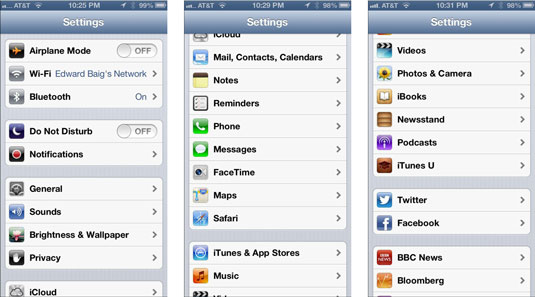When you first open Settings on your iPhone, you see the scrollable list. In all but airplane mode (at the top of the list), a greater-than symbol (>) appears to the right of each listing. This symbol tells you that the listing has a bunch of options.
Check out Settings on your iPhone and Airplane mode.

If you scroll down towards the bottom of the Settings list, you will see settings that pertain to Twitter and Facebook, and settings that pertain to some of the specific apps you’ve added to the iPhone.
Using a cell phone on an airplane is a no-no. But there’s nothing verboten about using an iPod on a plane to listen to music, watch videos, and peek at pictures — at least, after the craft has reached cruising altitude.
So how do you take advantage of the iPhone’s built-in Music player (among other capabilities) while temporarily turning off its phone, e-mail, and Internet functions? The answer is, by turning on airplane mode.
To do so, merely tap airplane mode on the Settings screen to display On (rather than Off). The good news is that airplane mode keeps your battery running longer — particularly useful if your flight is taking you halfway around the world.
Check out your Wi-Fi options.

Wi-Fi is typically the fastest wireless network you can use to surf the web, send e-mail, and perform other Internet tricks on the iPhone. You use the Wi-Fi setting to determine which Wi-Fi networks are available to you and which one to exploit based on its signal.
Tap Wi-Fi, and you see any Wi-Fi networks in range.
A signal-strength indicator can help you choose the network to connect to if more than one is listed; tap the appropriate Wi-Fi network when you reach a decision. If a network is password-protected, you see a lock icon.
You can also turn on or off the Ask to Join Networks setting. Networks that the iPhone is already familiar with are joined automatically, regardless of which one you choose. If the Ask feature is on, you’re asked before joining a new network. If it’s off, you have to select a network manually.
Check out your Bluetooth options.

On the iPhone, you can use Bluetooth to communicate wirelessly with a compatible Bluetooth headset or hands-free car kit. With the optional iPhone Bluetooth headset that Apple sells, you can automatically pair the devices by placing the iPhone and headset in a dual dock (supplied with the headset), which you connect to your computer.
If you’re using a third-party accessory, follow the instructions that came with that headset or car kit so that it becomes discoverable, or ready to be paired with your iPhone. Then turn on Bluetooth in Settings so that the iPhone can find such nearby devices and the device can find the iPhone. Bluetooth works up to a range of about 30 feet.
You know Bluetooth is turned on when you see the Bluetooth icon on the status bar. If the symbol is blue or white, the iPhone is communicating wirelessly with a connected device. (The color differences provide contrast to whatever is behind the icon.) If it’s gray, Bluetooth is turned on in the iPhone but a paired device isn’t nearby or isn’t turned on.
To unpair a device, tap it from the device list shown so that the word Connected becomes Not Connected. Tap the device again to reconnect.
To divorce a Bluetooth device from the iPhone, tap the right arrow in the blue circle to the right of the Bluetooth device you’re unceremoniously dumping. On the next screen, tap Forget This Device. At least you won’t have to pay alimony.






